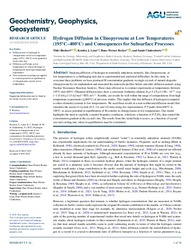Hydrogen Diffusion in Clinopyroxene at Low Temperatures (195°C–400°C) and Consequences for Subsurface Processes
DOI: https://doi.org/10.1029/2022GC010520
Persistent URL: http://resolver.sub.uni-goettingen.de/purl?gldocs-11858/11082
Persistent URL: http://resolver.sub.uni-goettingen.de/purl?gldocs-11858/11082
Supplement: https://doi.org/10.5281/zenodo.7290350
Bissbort, Thilo; Lynn, Kendra J.; Becker, Hans‐Werner; Chakraborty, Sumit, 2022: Hydrogen Diffusion in Clinopyroxene at Low Temperatures (195°C–400°C) and Consequences for Subsurface Processes. In: Geochemistry, Geophysics, Geosystems, Band 23, 12, DOI: 10.1029/2022GC010520.
 |
Dokument öffnen: |
Studying diffusion of hydrogen in nominally anhydrous minerals, like clinopyroxene, at low temperatures is a challenging task due to experimental and analytical difficulties. In this study, to overcome these problems we have produced H concentration gradients in single crystals of natural diopsidic clinopyroxene by ion implantation and measured the nanoscale profiles before and after diffusion anneals using Nuclear Resonance Reaction Analysis. These steps allowed us to conduct experiments at temperatures between 195°C and 400°C. Obtained diffusion rates show a consistent Arrhenius relation DH= 5.47(±13.98) · 10−8 · exp (−115.64(±11.5) kJ mol−1/RT) m2s−1. Notably, our results lie well within the range of extrapolations from high temperature experiments (≥600°C) of previous studies. This implies that fast diffusion of hydrogen (compared to other elements) extends to low temperatures. We used these results in a non‐isothermal diffusion model that simulates the ascent of crystals (0.5, 1.0, and 2.0 mm) along two representative P‐T‐paths from 600°C to 100°C, to assess potential re‐equilibration of H contents in clinopyroxene at low temperatures. Our model highlights the need to carefully consider boundary conditions, which are a function of P‐T‐f O2, that control the concentration gradient at the crystal's rim. The results from this model help to assess, as a function of crystal size and cooling rate, when re‐equilibration must be considered. Key Points:
Diffusion rates of hydrogen in clinopyroxene in the low temperature range (195°C–400°C) were quantified for the first time.
Diffusion coefficients at low temperatures lie within the range of extrapolations from high temperature experiments.
Non‐isothermal modeling was applied to evaluate potential re‐equilibration of clinopyroxene crystals at low temperatures.
Statistik:
ZugriffsstatistikSammlung:
This is an open access article under the terms of the Creative Commons Attribution License, which permits use, distribution and reproduction in any medium, provided the original work is properly cited.

